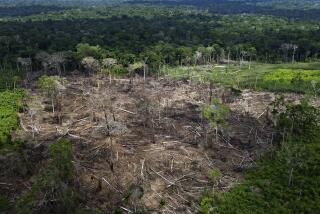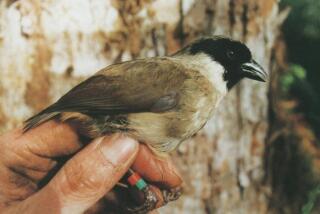Humans’ Destruction of Forests Threatens Species, Report Says
- Share via
WASHINGTON — Human destruction of forests and other ecosystems threatens to wipe out species on a scale unmatched since the dinosaurs disappeared, a report Saturday from an environmental research group asserted.
Rats, cockroaches and weeds may flourish in the void left by the destruction, the report said.
In Latin American forests alone, 15% to 66% of the estimated 92,000 plant species could be lost by the end of the century, the Worldwatch Institute said. Similarly, 12% to 69% of the bird species of the Amazon Basin could disappear as forest is cleared for farming, ranching and other development.
The institute is a Washington-based research organization that frequently reports on what it sees as environmental threats.
Most From Tropical Forests
Most of the species expected to be lost are from poorly explored tropical forests, said Edward Wolf, who wrote the report. Many of the species have not been named, much less studied, so “their potential value to society remains an unanswered question.”
Wolf said that up to one-fifth of the world’s estimated 5 million species could be lost in the next 20 to 30 years--a loss of several hundred a day and one “comparable to the extinctions revealed in the fossil record.”
The late Cretaceous extinctions 65 million years ago, when the dinosaurs vanished, destroyed 11% of marine animal families--groups of species--as well as 57% of reptile families and 32% of mammal families.
Since 66% of Latin American forest plants would be about 14% of the plant families, “the magnitude of impending extinctions clearly falls within the range of prehistoric extinctions,” Wolf wrote, although comparisons have to be provisional.
‘Ecological Opportunists’
“Extinction’s survivors, the record shows, tend to be ecological opportunists. They reproduce quickly, eat indiscriminately and tolerate a wide range of conditions--characteristics we associate with pests,” he said.
“Plankton that bloom uncontrolled after a marine extinction, birds like house sparrows and starlings, and the rats, cockroaches and weedy plants that flourish in disturbed environments all suppress the recovery of diversity by their prolific reproduction and intense competition for resources.”
Wolf quoted British environmentalist Norman Myers that it was “possible, even probable,” that in 50 years “we would have a disproportionate species we would characterize as ‘pest’ or weed species.”
Lost forest habitat may not be gone for good, Wolf wrote. But natural regeneration could take centuries--150 years from slash-and-burn farming; as many as 1,000 years from bulldozer clearing.
More to Read
Sign up for Essential California
The most important California stories and recommendations in your inbox every morning.
You may occasionally receive promotional content from the Los Angeles Times.













